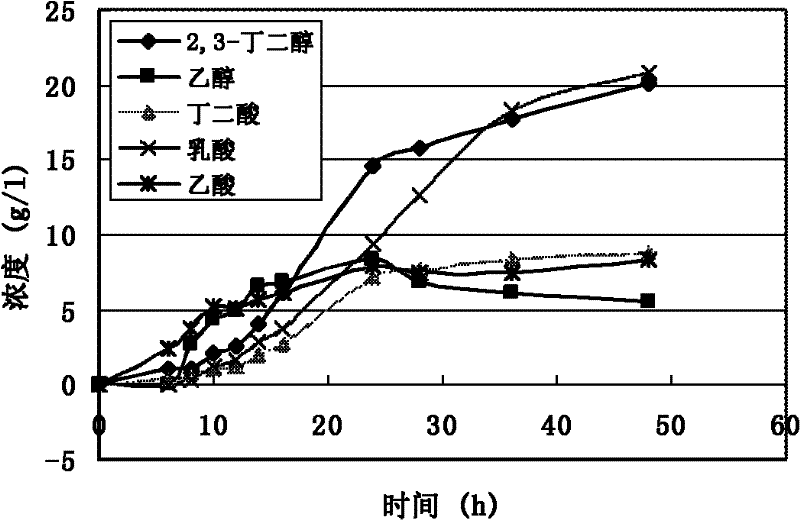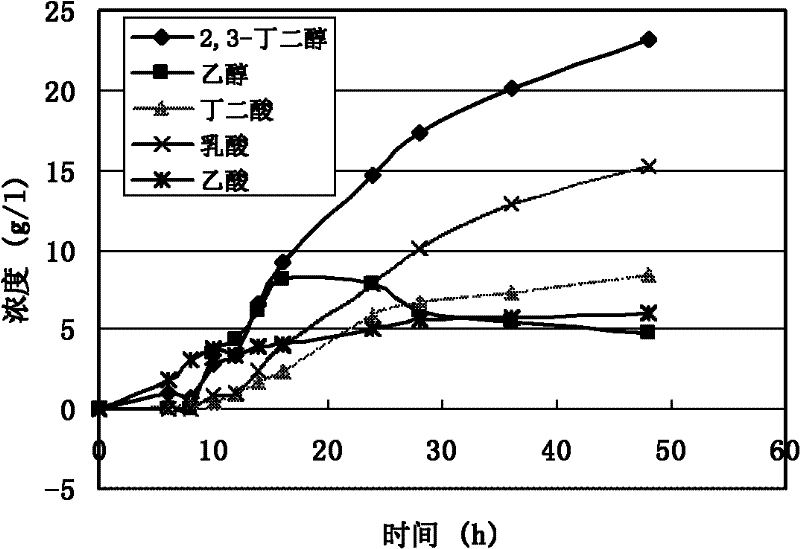Method for improving glycerol microbial fermentation production of 1,3-propanediol by constructing gene engineering bacterium
A technology of genetically engineered bacteria and propylene glycol is applied in the field of constructing genetically engineered bacteria to enhance microbial production, so as to achieve the effects of reducing production costs, improving production efficiency, and increasing concentration and yield.
- Summary
- Abstract
- Description
- Claims
- Application Information
AI Technical Summary
Problems solved by technology
Method used
Image
Examples
Embodiment 1
[0050] The construction of embodiment 1 genetically engineered bacteria
[0051] (1) Strain: the starting strain Klebsiella pneumoniae (CGMCC1.9131);
[0052] (2) Using Klebsiella pneumoniae (CGMCC1.9131) genomic DNA as a template, clone the malic enzyme gene by PCR (polymerase chain reaction); cloning primers are: upstream primer ME-F: 5' -gcgaattcatggatgagcagttaaaacag-3', downstream primer ME-R: 5'-cagtcgacttacagcggttcggtttgcg-3'; PCR conditions: pre-denaturation at 95°C for 5 minutes; denaturation at 94°C for 1 minute, annealing at 55°C for 1 minute, extension at 72°C for 3 minutes, 35 cycles, 72°C Extend for 10 minutes. The obtained malic enzyme gene PCR product sequence is shown in SEQ ID No.1.
[0053] (3) Purify the gene fragment of the malic enzyme gene PCR product and connect it to the cloning vector pMD18-T to transform the competent cell DH5α;
[0054] (4) Screen positive clones, cultivate, extract plasmids, digest with EcoR I and Sal I, reclaim, connect the expr...
Embodiment 2
[0057] The fermentation culture of embodiment 2 genetically engineered bacteria
[0058] (1) culture medium
[0059] LB medium (g·L -1 ): yeast powder 5, peptone 10, NaCl 10, agar 10, adjusted to pH 7.0, for short-term preservation and activation of Klebsiella species. The composition of seeds and fermentation medium is shown in Table 1:
[0060] Table 1 Medium Composition
[0061]
[0062] (2) Training method:
[0063] (i) Seed activation
[0064] The recombinant Klebsiella KP-pET-ME strain in Example 1 preserved in a glycerol tube was inoculated into LB medium slant for activation, and the seeds were incubated at 37° C. for 12 hours to activate the seeds.
[0065] (ii) Seed culture
[0066] Seed culture: 250mL triangular flask sealed with 9 layers of gauze, filled with 100mL of liquid, connected to a ring of slant lawn, aerobic seed culture in a shaker, temperature 30°C, speed 150r min -1 , add 50mg / l of kanamycin antibiotic in the culture medium.
[0067] (iii) F...
Embodiment 3
[0074] The fermentation culture of embodiment 3 genetically engineered bacteria
[0075] The recombinant Klebsiella KP-pET-ME strain constructed in Example 1 was used for fermentation and culture.
[0076] (1) Culture medium: the composition of the seed medium is the same as in Example 2, and the fermentation medium is the same as in Example 2 except that the initial glycerol concentration is 20g / l.
[0077] (2) Training method:
[0078] (i) seed activation, with embodiment 2;
[0079] (ii) seed culture, with embodiment 2;
[0080] (iii) Fermentation culture
[0081] When carried out in a 5L stirred fermenter, the liquid volume is 4L, the inoculum size is 1%, and 0.5vvm air is introduced to carry out the microaerobic fermentation culture, and the stirring speed is 250rpm. The fermentation temperature was kept constant at 37°C; the pH was adjusted to 6.8 by NaOH, and the pH of the system was regulated by feeding 40% NaOH solution during the fermentation process. After the ...
PUM
 Login to View More
Login to View More Abstract
Description
Claims
Application Information
 Login to View More
Login to View More - R&D
- Intellectual Property
- Life Sciences
- Materials
- Tech Scout
- Unparalleled Data Quality
- Higher Quality Content
- 60% Fewer Hallucinations
Browse by: Latest US Patents, China's latest patents, Technical Efficacy Thesaurus, Application Domain, Technology Topic, Popular Technical Reports.
© 2025 PatSnap. All rights reserved.Legal|Privacy policy|Modern Slavery Act Transparency Statement|Sitemap|About US| Contact US: help@patsnap.com



